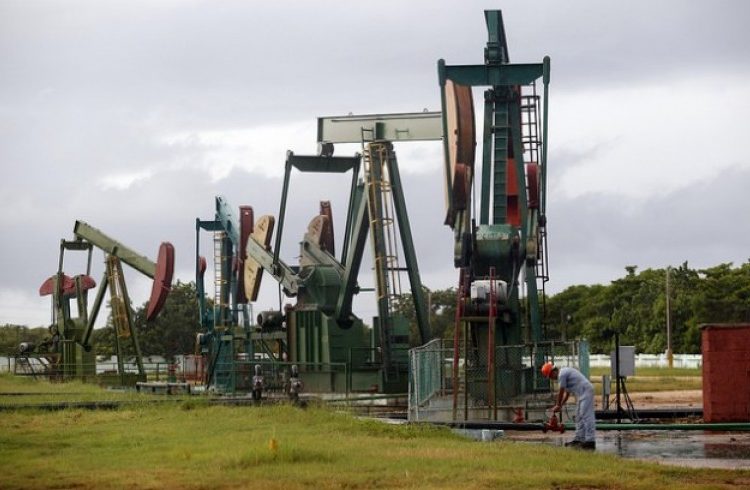The news that the intricate village of Motembo, in Villa Clara, could rise up out of anonymity and play a decisive role in the Cuban economy over the coming years, hit the press over the last few days. Estimates of probable oil stocks announced by the Australian company MEO in the area called Block 9 have rescued Motembo from the oblivion of 100 years, because it was there, in the nineteenth century, where the first well of light crude oil Cuba was discovered.
Many expectations and new hopes were created following the announcement, in times in which the reduction of oil supplies from Venezuela has raised in many the spectre of the Special Period. However, the news that it brought to my mind was the once more the reality of the evil that we have suffered for most of our history as a country: the energy dependence we have carried from the early twentieth century.
In Economics, dependence has many dimensions: energy, food, technological, financial, commercial … Cuba suffers them all. Some have also increased in these times, the result of the long crisis that we suffered from the early nineties of the last century and which we have not yet left behind. Structural deficits which our development efforts have failed to eliminate, sectoral policies that did not produce the expected results or were poorly designed or poorly implemented all contribute to our dependency.
Energy dependence is (perhaps with food) the one we feel the most, because it affects us every day, it gets on the bus, or into a surviving almendrón with us and is felt in all the climate controlled offices that do not turn on the air conditioning. If we try to do some business or some shopping in a store around noon, its more like entering into one of the circles of hell than into a business.
It also has some responsibility for the fact that when we are searching for a bottle of cold water we cannot find it, because there is no water or it is not cold, or we try to keep our heads level on one of the nights when for some reason there is no electricity supply or where we increasingly appeal to the fan as an environmentally friendly ventilation tool, above all in airports where we wait patiently to disembark or to collect our baggage.
Whenever there is the possibility of finding oil the hope confirmation grows in us all, that it might be a big find and might allow us a break in the importation bill. We almost always hope that luck will be all and that it will be enough to export, and that way we will be able to earn an income that will alleviate the external financial pressure. We remember that we already went through this feeling when they started deep-water drilling in the Gulf of Mexico a few years ago.
Oil and electricity still go hand in hand in the world and in Cuba. Electricity is by far the good and service that brings us closest to modernity and is perhaps one those that is essential for the prosperity of the people.
So it’s good to remember that:
1- Massive and cheap access to electricity is the product of the Cuban Revolution. Such access is conceptualised today as a critical element of prosperity.
2- Development programs that were implemented in Cuba always required a growing energy consumption.
3- Cuba had for almost thirty years, thanks to its relationship with the Soviet Union, a relatively easy and inexpensive access to primary carriers, or access to oil, with which we ended up consuming almost 13 million tons when we did not reach a population of 11 million Cubans. This means that every Cuban came to consume 1.18 tons per year, that is, 7.67 barrels per year (1 tonne = 6.5 barrels of oil more or less).
4- The country’s energy density (tons of oil per million pesos of GDP) was the highest in the world.
5- That easy and cheap access, set an energy matrix and consumption habits (in all sectors) that were very detached from our real capacity to sustain such levels of consumption.
6- The first 100 KW of domestic electricity consumption are still highly subsidized.
Our dependence on imported oil for electricity production is significant, as it also is for practically the rest of all activities.
Domestic oil production reached in 2002 reached 3,679,800 tons has been declining since then and in 2013 was 2,897,100 tons. That is 22% less.
It is also true that we used Cuban crude oi for generation and that it manages to cover a significant part of the generation, more than 50% of the time. It is also true that the Energás plants produces 12% of the country’s electricity with accompanying gas wells north of Havana and Matanzas. But we still depend on imported oil for the rest of the generation and that dependency becomes, in situations like the present, a great weakness.
While public figures from 2014 and 2015 are not available (for what reason, if we own them?) We can, however, make an estimate on the basis of unconfirmed reports that speak of an import of 100,000 barrels of oil per day from Venezuela, that is, 5.6 million tons. Assuming the same oil production as 2013, then oil imports would be 2.3 times that of the domestic production of the same fuel.
The original agreement with Venezuela, beneficial to both parties, provided for the sale of 53,000 barrels of oil to Cuba (2.5 million tons). For 80% of the supplies Cuba would pay the world market prices and within 90 days of delivery. The payment period for the remaining 20% could be between 5 and 20 years, depending on the average annual price that oil reached and Cuba would pay this fifth with the export of goods and services required for Venezuela’s socio-economic development programmes.
For 2016 and probably for years to come, everything is more complicated, because, as we know, the supply of oil from Venezuela has been significantly reduced, while oil production in that country is on a declining trend, and in July, according to information from OPEC, dropped to 2.095 million bpd from 2.115 million in June. The price of PDVSA’s oil basket dropped from $ 39.73 to $37. 67 a barrel.
In the face of this reality the concept of diversifying the Cuban energy matrix becomes even more important, something that was already raised five years ago in the [PCC’s] Guidelines and reiterated again in the programmatic documents still debated throughout the country.
The diversification of the matrix, distributed generation, and the introduction of low energy consumption technologies in lighting, for example, are projects that have been made reality in part due to the Energy Revolution ten years ago.
However, even today the energy matrix is about 95% dependent on fossil fuels that we need to import. Even today electricity generation using renewable sources does not exceed five percent of the total amount, globally it is about 12%, and in Latin America it is above 20%.
We still burn oil to heat the water we bathe in, most of the institutions that serve food burn oil to heat water with which it washes up, and our streetlights are mostly still shining from energy generation by the burning of oil.
Our strategy to reach 2030 with 24% of electricity generated from renewable sources, includes an investment of 3,600,000,000 dollars over the next 15 years, building 25 biomass power plants with (using sugar cane), plus 13 windfarms and installing photovoltaic panels.
Unfortunately, biomass generation projects, perhaps the best system of distributed generation that we could have, basically with bagasse, seem to be moving too slow for our needs. One bioelectrical plant (BIOPOWER, a joint venture) – at least that is publicly known – is in the process of creation.
We have advanced more in photovoltaic and wind energy, but unfortunately these sources only cover a small part of the demand.
Our power plants are still using diesel fuel and when the trend in the world is the use of cheaper, more efficient and less polluting liquefied gas; while investments in new capacities in those power plants, as far as has been made public, does not seem to change from diesel and gas fuel.
For some then, the resurgence of Motembo as a focus for oil exploitation once more appears as the great hope. Undoubtedly it would be very helpful in the short term for the MEO forecasts to become a reality, because we would see a boom period incomparable with anything before.
Hopefully by then, the dependency syndrome would be history. Because dependence is mostly a mental and cultural condition, which leads some to think that the conditions we enjoy or suffer from today will remain that way for ever.
We might avoid going from uncontrolled diabetes to terminal cirrhosis. Hopefully if we find oil, we will not turn luck and advantage into our next dependency, as was the case with sugar for many years. To have that luck, that the MEO forecast actually becomes true, then that resource should enable us to be more independent, even from oil itself.










